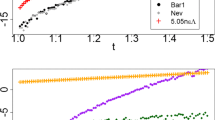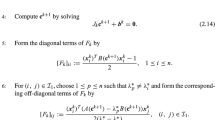Abstract
Computational aspects of implementation of the theory of differential corteges are considered. From a general viewpoint, a class tuple is described and recommendations and suggestions on its use are given; the use of the technique of computer differentiation is illustrated by examples.
Similar content being viewed by others
REFERENCES
G. F. Corliss, “Applications of differential arithmetic,” in: R.E. Moore (ed.), Reliability in Computing, Academic Press, London (1988), pp. 127-144.
L. B. Rall, “The arithmetic of differentiation,” Mathematical Magazine, No. 5, 275-282 (1986).
V. L. Rvachev and A. N. Shevchenko, Problem-Oriented Languages and Systems for Technical Computations [in Russian], Tekhnika, Kiev (1988).
A. N. Shevchenko and V. N. Rokityanskaya, “Automatic differentiation of functions of many variables,” Kibern. Sist. Anal., No. 5, 139-158 (1996).
A. Albert, Regression, Pseudo-Inversion, and Recurrent Estimation [Russian translation], Nauka, Moscow (1977).
V. L. Rvachev, Theory of R-Functions and Their Applications [in Russian], Naukova Dumka, Kiev (1982).
Author information
Authors and Affiliations
Rights and permissions
About this article
Cite this article
Rokityanskaya, V.N. Computational Aspects of the Technology of Computer Differentiation. Cybernetics and Systems Analysis 36, 776–783 (2000). https://doi.org/10.1023/A:1009497327095
Issue Date:
DOI: https://doi.org/10.1023/A:1009497327095




